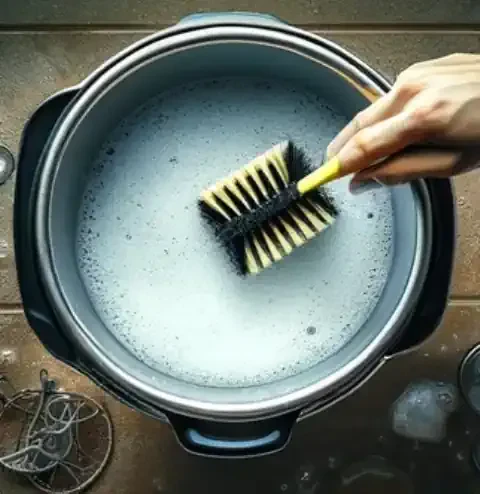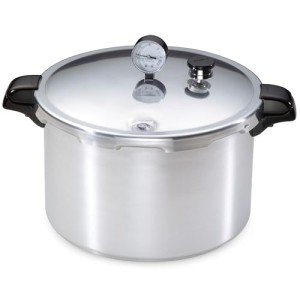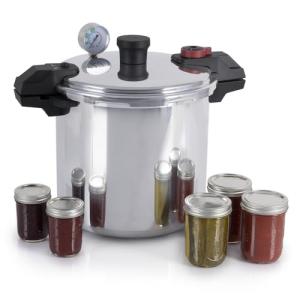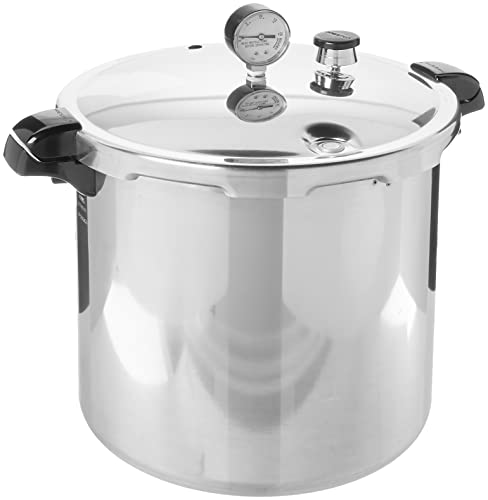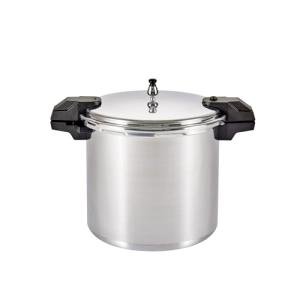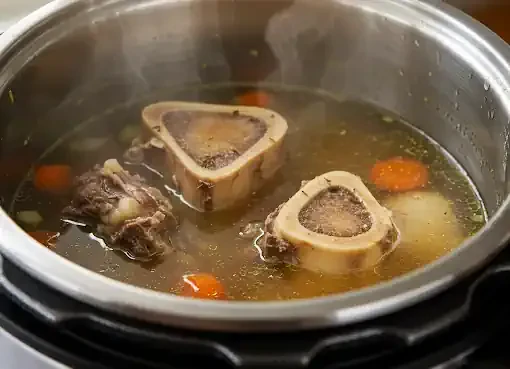Introduction: Why Cleaning Your Pressure Cooker Matters
Pressure cookers have revolutionized the way we prepare meals, offering speed, convenience, and energy efficiency. However, like any kitchen appliance, proper maintenance is crucial to ensure optimal performance and longevity. Cleaning your pressure cooker isn't just about aesthetics; it's a matter of safety, taste, and hygiene.
Why Is It Important To Clean Your Pressure Cooker?
Neglecting to clean your pressure cooker can lead to a buildup of food residue, grease, and odors. This can not only affect the taste of your dishes but also compromise the cooker's functionality. Over time, accumulated debris can clog the pressure release valve, leading to safety hazards. Additionally, a dirty pressure cooker can harbor bacteria, posing health risks for you and your family.
Regular cleaning is essential to:
Maintain safety: Prevent blockages in the pressure release valve and ensure proper pressure regulation.
Preserve flavor: Avoid off-putting tastes and odors transferring to your food.
Prevent bacterial growth: Keep your pressure cooker hygienic and safe for cooking.
Extend lifespan: Regular cleaning helps your pressure cooker last longer and perform better.
Different Types Of Pressure Cookers And Their Cleaning Needs
Pressure cookers come in various shapes, sizes, and materials, each with specific cleaning considerations.
Stovetop pressure cookers: These classic models typically have stainless steel or aluminum construction. They require manual pressure release and may need more thorough cleaning for the gasket and valve.
Electric pressure cookers: These modern appliances offer automated functions and often feature non-stick inner pots. While easier to clean overall, their electrical components require special attention.
Stainless steel pressure cookers: Known for their durability and ease of cleaning, stainless steel models may develop discoloration or water spots over time.
Aluminum pressure cookers: Lightweight and affordable, aluminum cookers require gentle cleaning to avoid scratching the surface.
Understanding your specific pressure cooker type is crucial for choosing the right cleaning methods and products.
Essential Tools And Cleaning Supplies For The Job
Before you begin cleaning, gather the following tools and supplies:
Dish soap: Choose a mild dish soap suitable for your pressure cooker's material.
Soft sponges or cloths: Avoid abrasive scrubbers that can scratch the surface.
Non-metallic brushes: These are helpful for cleaning crevices and hard-to-reach areas.
Baking soda: A natural cleaner and deodorizer, baking soda can help remove stubborn stains and odors.
Vinegar: Another versatile natural cleaner, vinegar is effective for descaling and removing mineral deposits.
Lemon juice: A natural disinfectant and deodorizer, lemon juice can leave your pressure cooker smelling fresh.
Warm water: Use warm water for most cleaning tasks, as hot water can damage some materials.
Optional: You may also want to have a descaling solution (for mineral buildup), stainless steel cleaner (for polishing), or a specialized pressure cooker cleaning product on hand.
By equipping yourself with the right tools and knowledge, you can ensure your pressure cooker remains a safe and reliable kitchen companion for years to come.
Daily Cleaning After Every Use
Maintaining your pressure cooker doesn't have to be a chore. By incorporating a quick cleaning routine after each use, you can prevent the buildup of grime and ensure your cooker stays in top shape.
Allow The Cooker To Cool Completely
Before you even think about cleaning, safety first! Always let your pressure cooker cool down completely. Forcing the lid open while it's still pressurized can be dangerous. Depending on the model and the amount of food cooked, this could take anywhere from 15 minutes to an hour. If you're short on time, you can quick-release the pressure, but make sure to do it safely by following your pressure cooker's instructions.
Release Pressure And Disassemble The Lid
Once the cooker is cool, release any remaining pressure by turning the pressure release valve or following the manufacturer's instructions. Next, carefully disassemble the lid. This usually involves removing the sealing ring and any other removable parts like the anti-block shield or float valve.
Wash The Inner Pot, Lid, And Sealing Ring
Wash the inner pot, lid, and sealing ring with warm soapy water. Use a soft sponge or cloth to avoid scratching the surfaces. Pay special attention to the sealing ring, as it can trap food particles and odors. Gently scrub it with a soft brush or toothbrush to remove any debris. If the sealing ring is removable, you can soak it in warm soapy water for a few minutes for a deeper clean.
Wipe The Exterior Of The Cooker
Wipe down the exterior of the pressure cooker with a damp cloth to remove any spills or splatters. If your cooker has a stainless steel exterior, you can use a stainless steel cleaner to remove fingerprints and smudges. For stubborn stains, you can make a paste of baking soda and water and apply it to the affected area. Let it sit for a few minutes before wiping it away with a damp cloth.
Deep Cleaning: When And How Often
While daily cleaning after each use is essential, your pressure cooker also requires a deeper clean on a less frequent basis. This more thorough cleaning will address areas that aren't typically cleaned during daily maintenance and ensure your pressure cooker remains in pristine condition.
Signs That Your Pressure Cooker Needs A Deep Clean
How do you know when your pressure cooker needs a deep clean? Look out for these telltale signs:
Lingering odors: If your pressure cooker retains a persistent food odor even after washing, it's a sign that residues have built up in areas not reached during daily cleaning.
Visible buildup: Check the sealing ring, pressure release valve, and other nooks and crannies for any visible residue or discoloration.
Difficulty sealing: If the lid doesn't seal properly or steam escapes from unexpected areas, it could indicate a buildup of food particles or debris interfering with the seal.
Reduced performance: If your pressure cooker takes longer to reach pressure or the cooking time seems extended, it might be due to a dirty pressure release valve or clogged steam vent.
Recommended Frequency Of Deep Cleaning
The frequency of deep cleaning depends on how often you use your pressure cooker and the types of foods you cook. As a general rule of thumb:
Frequent users: If you use your pressure cooker almost daily, aim to deep clean it every 1-2 months.
Occasional users: If you use your pressure cooker less frequently, deep cleaning every 3-4 months should suffice.
Sticky or smelly foods: If you frequently cook sticky or strong-smelling foods, you might need to deep clean more often.
Ultimately, use your judgment and the signs mentioned above to determine the appropriate deep cleaning schedule for your pressure cooker.
Preparing The Pressure Cooker For Deep Cleaning
Before you begin deep cleaning, take the following steps:
Unplug (if electric): If you have an electric pressure cooker, unplug it from the power source for safety.
Disassemble: Take apart the pressure cooker completely, including the lid, sealing ring, pressure release valve, and any other removable parts.
Soak: If there's significant buildup or stuck-on food, soak the removable parts in warm soapy water for 15-20 minutes.
Special Considerations For Electric Pressure Cookers
Electric pressure cookers have additional components that require attention during deep cleaning.
Heating element: Use a damp cloth to wipe the heating element, being careful not to immerse it in water.
Control panel: Clean the control panel with a slightly damp cloth, avoiding excessive moisture.
Exterior: Wipe down the exterior with a damp cloth and a mild cleaning solution.
Other parts: Follow the manufacturer's instructions for cleaning any other specific parts of your electric pressure cooker.
By following these guidelines, you can ensure that your pressure cooker remains in top-notch condition, guaranteeing safe and efficient cooking experiences for years to come.
Cleaning The Main Components: Inner Pot and Lid
Your pressure cooker's main components, the inner pot and lid, require special attention during deep cleaning. These parts come into direct contact with food and are prone to accumulating residue and stains. By focusing on these key areas, you can ensure optimal hygiene and performance for your pressure cooker.
Cleaning The Inner Pot
The inner pot is where the magic happens – where your ingredients transform into delicious meals under pressure. However, it's also prone to collecting stuck-on food, discoloration, and odors. Here's how to tackle these issues:
Removing Stuck-On Food
For mild food residue, simply soak the inner pot in warm soapy water for 15-20 minutes. Then, use a soft sponge or cloth to gently scrub away any remaining debris. Avoid using abrasive scrubbers, as they can scratch the surface.
If you're dealing with stubborn stuck-on food, try these methods:
Baking soda paste: Make a paste of baking soda and water, apply it to the affected areas, and let it sit for a few minutes. Then, scrub gently with a non-abrasive pad.
Vinegar soak: Fill the inner pot with a solution of equal parts water and vinegar. Let it soak for 30 minutes to an hour, then scrub away any loosened food particles.
Pressure cooking method: For extreme cases, fill the inner pot with water and a few tablespoons of baking soda or vinegar. Close the lid and cook on high pressure for a few minutes. Let the pressure release naturally, then wash as usual.
Dealing With Discoloration
Stainless steel inner pots may develop discoloration or rainbow stains over time. This is usually caused by minerals in the water or high heat. To remove these stains, try the following:
Vinegar solution: Fill the inner pot with a solution of equal parts water and vinegar. Let it soak for an hour, then scrub gently with a non-abrasive pad.
Bar Keepers Friend: This cleaning product is specifically designed to remove stains from stainless steel. Follow the instructions on the packaging.
Lemon juice and baking soda: Make a paste of lemon juice and baking soda, apply it to the stains, and let it sit for a few minutes. Then, scrub gently and rinse thoroughly.
How To Deodorize The Inner Pot
If your inner pot has lingering odors, you can eliminate them with these simple methods:
Baking soda: Sprinkle baking soda on the bottom of the pot, add water to cover, and let it soak overnight. Then, wash as usual.
Lemon juice: Fill the pot with water and add the juice of one lemon. Boil the mixture for a few minutes, then let it cool and wash as usual.
Activated charcoal: Place a few pieces of activated charcoal in the pot and leave it overnight. The charcoal will absorb the odors.
Cleaning The Lid And Sealing Ring
The lid and sealing ring are essential for maintaining pressure and preventing leaks. Regular cleaning is crucial to ensure a tight seal and prevent food particles from getting trapped.
Checking For Damage Or Wear
Before cleaning the lid and sealing ring, inspect them for any signs of damage or wear, such as cracks, tears, or warping. If you notice any damage, replace the parts immediately to avoid safety hazards.
Properly Cleaning The Sealing Ring
The sealing ring is a magnet for food particles and odors. Remove it from the lid and wash it thoroughly with warm soapy water. You can use a soft brush or toothbrush to reach into the crevices and remove any debris. If the sealing ring is dishwasher safe, you can wash it on the top rack.
Reassembling The Lid
After cleaning, reassemble the lid according to the manufacturer's instructions. Ensure the sealing ring is properly seated and the lid is securely fastened before using the pressure cooker.
By giving proper attention to the inner pot and lid, you'll ensure your pressure cooker remains a reliable and hygienic tool for your culinary adventures.
Cleaning The Pressure Release Valve And Other Parts
The pressure release valve and other smaller components of your pressure cooker play a crucial role in its safe and efficient operation. These parts can accumulate debris and residue over time, hindering their functionality. Regular cleaning ensures that your pressure cooker operates at peak performance and prevents potential hazards.
Disassembling The Pressure Release Valve
The pressure release valve is responsible for regulating the pressure inside the cooker, making it a vital component for safety. To clean it effectively, you need to disassemble it according to your pressure cooker model's instructions. Generally, this involves removing the valve cap, spring, and any other removable parts.
Cleaning The Valve With Soapy Water Or Vinegar
Once disassembled, clean the individual parts of the pressure release valve with warm soapy water. Use a small brush or pipe cleaner to reach into the crevices and remove any trapped food particles or debris. If you notice mineral buildup or discoloration, soak the parts in a vinegar solution for a few hours. This will help loosen the deposits and make them easier to remove.
Cleaning Other Parts Like The Steam Rack Or Trivet
Don't forget about the other smaller parts of your pressure cooker, such as the steam rack or trivet. These can also accumulate food residue and stains. Wash them with warm soapy water and a soft sponge or cloth. For stubborn stains, you can use a baking soda paste or soak them in a vinegar solution.
Reassembling The Pressure Release Valve
After cleaning and thoroughly drying all the components, reassemble the pressure release valve carefully. Make sure all the parts are correctly aligned and secure before using your pressure cooker again. A properly functioning pressure release valve is crucial for safe cooking.
By paying attention to these often overlooked components, you can ensure that your pressure cooker functions safely and efficiently, allowing you to enjoy delicious and stress-free cooking experiences.
Addressing Common Cleaning Challenges: Burnt Food, Mineral Deposits, and Odors
Even with regular cleaning, pressure cookers can face some common challenges like burnt-on food, mineral deposits, and lingering odors. Don't worry, though – these issues are easily tackled with some simple solutions and cleaning hacks.
Removing Burnt-On Food
Burnt-on food can be a real headache to clean, but it doesn't have to be a lost cause. Here are a few effective methods to remove burnt-on food from your pressure cooker:
Soaking With Baking Soda And Water:
Create a paste by mixing baking soda with water and apply it to the burnt areas. Let it sit for a few hours or overnight. The baking soda will help loosen the burnt-on food, making it easier to scrub away with a non-abrasive pad.
Using A Vinegar Solution:
Fill the inner pot with a solution of equal parts water and vinegar. Bring it to a boil and let it simmer for 15-20 minutes. The acidity of the vinegar will help break down the burnt-on food. After simmering, let it cool and scrub away the residue.
Scrubbing With A Non-Abrasive Pad:
For less stubborn burnt-on food, you can try scrubbing it with a non-abrasive pad and warm soapy water. Be patient and avoid using excessive force, as you don't want to scratch the surface of your pressure cooker.
Dealing With Mineral Deposits Or Limescale
If you live in an area with hard water, you might notice mineral deposits or limescale buildup in your pressure cooker. These deposits can affect the performance of the cooker and make it look less appealing. Here's how to tackle this issue:
Vinegar Soak Or Descaling Solution:
Fill the inner pot with a solution of equal parts water and vinegar or use a commercially available descaling solution. Let it soak for several hours or overnight. This will help dissolve the mineral deposits. Afterward, scrub the pot with a soft sponge or cloth and rinse thoroughly.
Preventing Future Buildup:
To prevent future buildup, try using filtered or distilled water in your pressure cooker. You can also add a tablespoon of white vinegar or lemon juice to the cooking water to help prevent mineral deposits from forming.
Eliminating Odors From The Pressure Cooker
Lingering food odors can be unpleasant and affect the taste of your next dish. Here are a few ways to get rid of unwanted odors from your pressure cooker:
Lemon Juice And Water Mixture:
Fill the inner pot with water and add the juice of one lemon. Boil the mixture for a few minutes, then let it cool and wash as usual. The citric acid in lemon juice helps neutralize odors.
Baking Soda Paste:
Make a paste of baking soda and water and apply it to the interior of the pressure cooker. Let it sit for a few hours, then wipe it away with a damp cloth and rinse thoroughly.
Activated Charcoal:
Place a few pieces of activated charcoal in the pressure cooker and leave it overnight. The charcoal will absorb the odors, leaving your pressure cooker smelling fresh.
By addressing these common cleaning challenges, you can keep your pressure cooker in top condition, ensuring it continues to deliver delicious meals for years to come.
Cleaning Specific Types Of Pressure Cookers
Different pressure cookers have unique characteristics and cleaning requirements. Understanding these nuances will help you tailor your cleaning approach to ensure the longevity and optimal performance of your specific model.
Stainless Steel Pressure Cookers
Stainless steel pressure cookers are known for their durability and resistance to corrosion. However, they can develop discoloration or water spots over time. To keep them looking their best:
Avoid harsh abrasives: Use non-abrasive cleaners and soft cloths to prevent scratching the surface.
Tackle discoloration: Remove discoloration with a paste of baking soda and water or a stainless steel cleaner.
Prevent water spots: Dry the cooker thoroughly after washing to prevent water spots from forming.
Aluminum Pressure Cookers
Aluminum pressure cookers are lightweight and affordable, but they require a gentler cleaning approach.
Avoid harsh chemicals: Use mild dish soap and avoid harsh chemicals or abrasive cleaners that can damage the surface.
Remove discoloration: If your aluminum cooker becomes discolored, try boiling a mixture of water, vinegar, and apple peels. The acid in the vinegar and apples will help remove the discoloration.
Prevent pitting: Avoid using acidic ingredients like tomatoes or citrus fruits directly in the cooker, as they can cause pitting.
Electric Pressure Cookers
Electric pressure cookers offer convenience and a wide range of functions, but they also have unique cleaning considerations.
Cleaning The Heating Element:
The heating element is crucial for the proper functioning of your electric pressure cooker. To clean it, unplug the cooker and allow it to cool completely. Then, wipe the heating element with a damp cloth, being careful not to immerse it in water.
Cleaning The Control Panel:
The control panel can accumulate fingerprints and food splatters. To clean it, use a slightly damp cloth and a mild cleaning solution. Avoid using excessive moisture, as it could damage the electronic components.
Stovetop Pressure Cookers
Stovetop pressure cookers require more manual intervention than electric models, but they are often preferred for their precise pressure control and versatility. When cleaning, pay special attention to the gasket and pressure release valve, as these parts are prone to accumulating debris.
Gasket: Remove the gasket and wash it thoroughly with warm soapy water. Inspect it for any signs of wear or damage and replace it if necessary.
Pressure release valve: Disassemble the valve and clean it with soapy water or a vinegar solution. Use a small brush or pipe cleaner to reach into the crevices.
By understanding the specific cleaning requirements for your pressure cooker type, you can ensure that it remains in top condition and continues to deliver delicious meals for years to come.
Natural Cleaning Solutions For Your Pressure Cooker
In addition to commercial cleaning products, several natural household ingredients offer safe and effective cleaning solutions for your pressure cooker. These eco-friendly alternatives are not only gentler on your appliance but also safer for your health and the environment.
Baking Soda
Baking soda, a staple in many kitchens, is a versatile cleaning agent for your pressure cooker. Its mild abrasiveness helps remove stuck-on food and stains without scratching the surface. Baking soda also acts as a natural deodorizer, absorbing and neutralizing unpleasant smells.
To use baking soda for cleaning:
Create a paste: Mix baking soda with water to form a paste and apply it to stained or greasy areas. Let it sit for a few minutes, then scrub gently with a soft cloth or sponge.
Deodorize: Sprinkle baking soda on the bottom of the inner pot, add water to cover, and let it soak overnight. The baking soda will absorb any lingering odors.
Vinegar
Vinegar, another kitchen essential, is a powerful natural cleaner and disinfectant. Its acidic nature helps break down mineral deposits, grease, and grime. Vinegar is particularly effective for descaling your pressure cooker and removing hard water stains.
To use vinegar for cleaning:
Descale: Fill the inner pot with equal parts water and vinegar. Bring it to a boil and let it simmer for 15-20 minutes. Let it cool, then scrub and rinse thoroughly.
Clean and deodorize: Mix equal parts water and vinegar in a spray bottle. Spritz the solution on the interior and exterior of the cooker, let it sit for a few minutes, then wipe clean.
Lemon Juice
Lemon juice is a natural disinfectant and deodorizer, leaving your pressure cooker smelling fresh and clean. Its acidity can also help break down grease and grime.
To use lemon juice for cleaning:
Deodorize: Fill the inner pot with water and add the juice of one lemon. Boil the mixture for a few minutes, then let it cool and wash as usual.
Clean: Cut a lemon in half and rub it on stained or greasy areas. Let it sit for a few minutes, then scrub with a soft cloth or sponge.
Other Natural Cleaners
In addition to baking soda, vinegar, and lemon juice, other natural ingredients can also be used for cleaning your pressure cooker.
Salt: Coarse salt can act as a gentle abrasive to scrub away stuck-on food.
Cornstarch: Cornstarch can be used to polish stainless steel surfaces and remove water spots.
By incorporating these natural cleaning solutions into your pressure cooker maintenance routine, you can ensure a clean and hygienic appliance while minimizing your impact on the environment.
Tips For Maintaining Your Pressure Cooker
Proper maintenance is key to maximizing the lifespan and performance of your pressure cooker. By following these simple tips and incorporating them into your routine, you can ensure your pressure cooker remains a reliable kitchen companion for years to come.
Regularly Inspect The Sealing Ring
The sealing ring is a critical component of your pressure cooker, creating an airtight seal to build and maintain pressure. Over time, the sealing ring can wear out, crack, or become brittle. Regularly inspect the sealing ring for any signs of damage or wear. If you notice any issues, replace the sealing ring immediately to ensure the safety and efficiency of your cooker.
Store The Pressure Cooker Properly
When not in use, store your pressure cooker in a cool, dry place. Avoid storing it with the lid on, as this can trap moisture and create a breeding ground for bacteria. If possible, store the lid separately or upside down on the pot to allow air circulation.
Avoid Harsh Chemicals Or Abrasive Cleaners
Harsh chemicals and abrasive cleaners can damage the surface of your pressure cooker and shorten its lifespan. Stick to mild dish soap, baking soda, vinegar, and other natural cleaners mentioned earlier. Always use soft sponges or cloths to avoid scratching the surface.
Follow The Manufacturer's Instructions
Your pressure cooker comes with a user manual that contains specific cleaning and maintenance instructions. Always refer to the manufacturer's guidelines for the best practices for your particular model. This will ensure that you are cleaning your pressure cooker correctly and not inadvertently causing any damage.
Additional Tips For Longevity
Here are some additional tips to help prolong the life of your pressure cooker:
Don't overheat: Avoid overheating your pressure cooker, as this can damage the sealing ring and other components.
Use enough liquid: Always use the minimum amount of liquid specified in your recipe to ensure proper pressure buildup and prevent food from burning.
Clean promptly: Clean your pressure cooker soon after use to prevent food from hardening and becoming difficult to remove.
Descale regularly: If you have hard water, descale your pressure cooker regularly to prevent mineral buildup.
Lubricate the sealing ring: Apply a thin layer of cooking oil to the sealing ring occasionally to keep it supple and ensure a tight seal.
By following these maintenance tips, you can keep your pressure cooker in peak condition, ensuring it continues to serve you well for many delicious meals to come.
Summary
This comprehensive guide provides step-by-step instructions on how to clean and maintain your pressure cooker effectively. It covers daily cleaning routines, deep cleaning methods for tackling stubborn residues and odors, and specific tips for different pressure cooker types (stainless steel, aluminum, electric, and stovetop). The guide also offers natural cleaning solutions using baking soda, vinegar, and lemon juice, emphasizing safety and longevity for your appliance. By following these expert recommendations, you can ensure your pressure cooker remains a reliable and hygienic tool for creating delicious meals for years to come.
